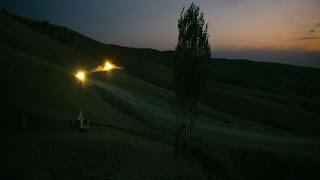
Turkish cinema made an impact on the world map in the early Eighties essentially because the honest nationalist realism of the Kurd actor/screenplay-writer/director Yilmaz Güney was blooming and gaining world attention. Güney, like many outstanding Iranian filmmakers today, was imprisoned in Turkey again and again, as he was perceived to be an inconvenient threat to the government until he died in 1984 in exile. With his passing, there seemed to be no one who could fill Güney’s boots for two decades. Eventually, two Turkish directors Nuri Bilge Ceylan and Semih Kaplanoglu have emerged and raised Turkey’s profile once again in contemporary world cinema as no other, with achievements that shadow each other. Both have already made film trilogies: Ceylan, a trilogy referred to as ‘the provincial trilogy’, and Kaplanoglu the ‘Yusuf’ trilogy. Ceylan (born in 1959) is some 4 years older to Kaplanoglu (born in 1963). Both have made about five to six feature films. Both began as photographers/cameramen, graduating to becoming the toast of major film festivals such as Cannes and Berlin as film directors. Both cast their own family members as actors and crew in their films. Both have not just proved their abilities as filmmakers but have in their films indirectly promoted the natural splendours of the Turkish landscape to the world audiences to devour.
This is a perspective that a viewer of Nuri Bilge Ceylan’s latest work Once Upon a Time in Anatolia ought not to ignore. Ostensibly a long feature film on the investigation of a murder, the cinematic work offers much more to an attentive and patient viewer. Ceylan’s interest in photography is probably most evident when he collaborates with his cinematographer, Gökhan Tiryaki, in his past three feature films. The visually rich Turkish film Once Upon a Time in Anatolia demands a lot from its viewer as the visuals compete for attention of the viewer as much as the narrative. Viewers, unfamiliar with Turkey, would wonder where Anatolia is on the modern global map. When the Italian filmmaker Sergio Leone made films with similar titles, his “West” and his “America” were not difficult to pinpoint. When the Mexican filmmaker Robert Rodriguez reprised the phrase in his 2003 film with “Mexico,” once again the geography was easy to pinpoint and unambiguous. Not so with Anatolia.
Anatolia is an ancient name for much of modern Turkey. It is the name associated with much of Turkey from the days of Alexander the Great. What is important for the viewer to note and reflect on is that Ceylan chose the term Anatolia rather than Turkey, when the tale he presents is of modern day Turkey, of individuals and mindsets that are not historical but contemporary. Perhaps for Ceylan and co-sciptwriters (comprising his wife Ebru Ceylan and Ercan Kasal, the very same team that wrote the brilliant Three Monkeys) the mindset and values have not changed with time and perhaps for them modern Turkey is no different from Anatolia of the ages past.

The viewer is presented a murder story that begins in the night. By the end of the film, the truth behind the murder is unravelled, with visuals bathed in sunlight. The journey from darkness to light reveals a lot more than the solving of a murder. The tale is one that goes beyond the story of any one individual but of many individuals, powerful individuals, less powerful mortals on the fringes of society, individuals living in towns and individuals living in the villages, individuals educated and not so educated. Some individuals murder human beings, others murder truth. The title of the film suggests that the viewer is being told an old fable, but the viewer will soon realize the film is a contemporary tale, a melancholy one that suggests more than what is obvious on a casual viewing.
A prosecutor dictates a report that will have legal muscle, which is essentially his own parochial view, without any real questioning or discussions. A doctor conducts an autopsy without touching the corpse. A village elder passionately demands a morgue in a village which has poor electrical connections rather than ask for any other modern amenity one associates with progress. Ceylan’s film is crowded with male characters, with only two female characters appearing briefly on screen, and one (the prosecutor’s dead wife) who never appears physically but is discussed at length. In the middle of the cinematic investigation of the murder of a man someone suggests “Look for the woman.” The film develops into an autopsy of male minds rather than of a male corpse. The irony that the script gradually develops gets further underscored by the scientifically rigid doctor, who is a votary of autopsies to investigate abnormal deaths, deciding to doctor the autopsy at hand, after looking out of the window at a woman.
Once Upon a Time in Anatolia, the viewer will realize, is less about the investigation of a murder than an investigation of a social psyche of a people who have not changed over the ages. Ceylan makes you wonder if truth was ever documented in the region but buried alive because it was convenient.
Though the bulk of the film is talk-heavy, the film’s strength lies in the visuals. The prologue of the film, before title credits, reveal three men talking in a large room in the night, followed by a shot of that building from the outside, patrolled by a stray dog, and finally that vision is finally cut off by a passing truck. Dogs reappear at critical moments again in Once Upon a Time in Anatolia—once again when the body is found and later at the gates of the village elder. Having visited Turkey on two occasions, this critic finds the role of the dogs in the film surprising, as stray dogs are rare to spot in that country compared to well-fed stray cats. Evidently, Ceylan employs dogs to tell the viewer something; perhaps it is a mere a cinematic punctuation in the tale, perhaps more. This critic does not recall dogs appearing in either Climates (2006) or Three Monkeys (2008), the two preceding Ceylan films.

Visuals continue to be important in this film. At the end of the superb Three Monkeys, dark clouds, a lovely metaphor, loomed over the Marmara Sea. In Once Upon a Time in Anatolia, thunder and lightning are heard and seen but no rain falls on the beautiful weather beaten landscape. In fact, the lightning lights up a carving on the rocky hillside scaring the wits out of a man with much to hide in his life. When the electricity in the village fails, Ceylan and Tiryaki, introduce the village elder’s beautiful daughter’s face illuminated in the dark by lamps and candles for a short sequence as she silently serves tea to the guests. The effect of her appearance and presence is felt by the men on the screen, harking back to the women in their lives. It is a great moment of epiphany. Soon after that the prisoner in the group exclaims aloud as he sees a man who he thought was dead.

And again, much later, it is the final image of the dead man’s wife walking on a lonely path, as seen from the autopsy room, which brings the cinematic tale to a closure.
Ceylan’s film is about women seen through the eyes of men. Somewhere in the film the prosecutor tells the doctor: “Women can sometimes be very ruthless.” Much later in the film, after long exchanges of views with the doctor, the prosecutor concludes himself, that the death of his “gorgeous” wife was not as he had made it out to be all these years. Men cheat on their wives, they kill for the sake of women they love, and yet consider these women to be ruthless even in their stoic silence captured by the film. These are vignettes of Anatolia over the ages, repeated to this day. Ceylan seems to ask the viewer to reassess history in this context.
Ceylan’s use of the camera to track the fall of an apple from a tree, rolling down the slopes and a stream to settle where other such fallen apples are gathered speaks a lot for his metaphoric ability to connect nature and man. Even when a child throws a tomato at his father (not knowing the kinship) the camera focuses on the emotions of the mother and father, and those images unveil a story never directly discussed in the movie.
The remarkable aspect of Nuri Bilge Ceylan’s cinema is that he presents the obvious contradictions in society; he refrains from taking a high moral ground. He leaves it to the viewer to decide every issue each viewer has perceived in his films.
Once Upon a Time in Anatolia won the Grand Prix at Cannes in 2011, the second highest award at the event after the Golden Palm. (Ceylan might have won the Golden Palm if Terrence Malick’s film The Tree of Lifewas not competing with his film.) It has also won the best film award at the Haifa Film Festival, the grand prize of the critics at Sao Paolo Film festival, the Grand Jury Prize at the Asia Pacific Screen awards, and the special jury award at the Dubai film festival. Ceylan’s film can appear to be lengthy and tedious, but the film offers delightful stories within the main story, some said, some unspoken. It is for the alert viewer to pick up the strands such as this comment from the prosecutor: “You don’t know how boys suffer here, without a father. It’s the kids who suffer most in the end, doctor, it’s the kids who pay for the sins of adults.” The film is in a way the collective, melancholic story of Anatolia over the ages repeating over the many generations. To call the film “Once Upon a Time in Turkey” would have missed the director’s implicit intent.
P.S. Once Upon a Time in Anatolia ranks as one of the 10 best films of 2011 for the author. Ceylan’s Three Monkeys (2008) ranks as one of the 100 best films of the author. Sergio Leone’s Once Upon a Time in America (1968) and Semih Kaplanoglu’s Honey (2010) were reviewed earlier on this blog.
<a href="http://feedjit.com/">Feedjit Live Website Statistics</a>

